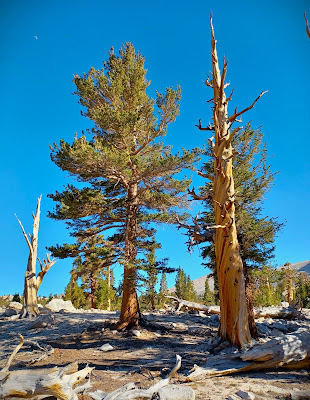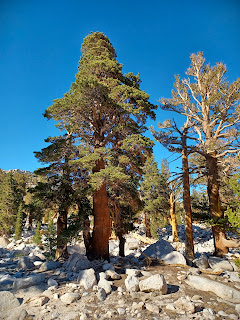Ascending Mount Langley: Reflections from the High Sierra - Part Seven
By Armando Ortiz
Final Reflections:
Did you ever cram for a test the night before? Long hikes and backpacking are quite the opposite. They require time, effort and thorough preparation. After my backpacking trip, I realized how crucial preparation is for long treks. This involves consistent practice and training. You must work out regularly. You can’t decide that you will hike Mt. Langley the day before- it can be dangerous.
Before this trip I’d been hiking 4 to 6 miles on the weekends, regularly increasing the distance and elevation as summer approached. Each hike included carrying a 15 to 17 pound pack, building my resistance and endurance. During the weekdays, I took daily walks and lifted light weights twice a week. The week before trekking up to Mt. Langley, I completed a 15-mile hike up White Mountain Peak with a 3,400 feet elevation gain, which indicated I was ready for Mt. Langley- a two-day trip with an additional 5-6 miles and double the pack weight.
Looking back, my clothing was sufficient, but I’d make some minor changes. A long sleeve shirt, and windbreaker provided good sun protection, but a long sleeve hoodie, a good cap, and a rain jacket would be perfect for high elevations. This setup gives me cover from the sun, wind resistance, and insulation. While my sun hat worked well, using the hoodie in windy conditions covered my ears, affecting my peripheral vision and muffling sounds.
The water filter worked fine, and knowing that there was a source near the camp to fill two liters of water was convenient. Using a light dayback for the summit gave me more freedom of movement and allowed me to just carry the bare essentials, making the climb faster. However, my main pack, over 20 years old, couldn’t distribute the weight evenly. The straps loosen up, and the shoulder straps dug into my shoulders. A new pack is needed for better performance.
I brought more food than necessary, adding weight to the pack. The extra food provided an option to stay another night and rest after the summit, though I didn’t take advantage of that opportunity. I carried energy bars- blueberry and lemon. Interestingly, my taste changed slightly at higher elevations. The spiciness and saltiness of peanuts were nourishing, but the lemon snacks were tastier, with their chewy tartness providing an extra kick of satisfaction.
Monitoring my hiking app for trail updates and tracking the weather conditions online helped me to choose the best route. Before the trip, I read that New Army Pass, though longer, was safer. Knowing as much as possible about the trail conditions is always helpful. Dedicating time to study the topography of the wilderness area helped me anticipate sections along the trail. I knew that reaching High Lake would be moderately easy, with 400 feet elevation gain. By studying the map I was able to identify water sources, with High Lake being the last one before going up Mt. Langley. The toughest section of the trail was near the summit, with eroded terrain, but the cairns facilitated navigation.
Choosing a better location to camp that was less strenuous to the body could have spared unnecessary energy expenditure. Staying one or two miles further down the trail would have reduced the burden of carrying a heavy pack. The one lesson learned was to take down camp and leave everything packed for the return if not planning to stay the night.
Rushing and trying to race the sun gets you in trouble. My arrival was delayed due to the drive, and I started later than expected. Lunch was rushed because I wanted to reach High Lake before sundown. The next day, after a full day of hiking, I quickly packed up to beat the sun. Pushing my body to its limits was risky. My knee, already bothering me before the trip, worsened due to the rush. Being well rested is essential for a successful trek, especially before covering many miles in a day, but also pacing yourself and being aware of time.
Finally, car maintenance is crucial for any long trip. Although I checked the oil before leaving, inspecting other parts like air filters, tire pressure, and the radiator cap could have prevented potential issues. Ensuring your vehicle is in good condition contributes to a successful trip.
Preparation gives you mental space and physical endurance to make informed choices. During a trek, if you feel like you’re disoriented physically or mentally, you can take a moment to pause, breathe, and reflect before making the next decision. At the summit, I wondered how Covid-19 might have affected our physical endurance. Yet, I successfully submitted Mt. Langley. Fortunately, my body persevered, and I made it back to my car. This experience reinforced the importance of preparation and planning for any endeavor, ensuring a successful summit, hike, backpacking expedition or trip into the wilderness.

















